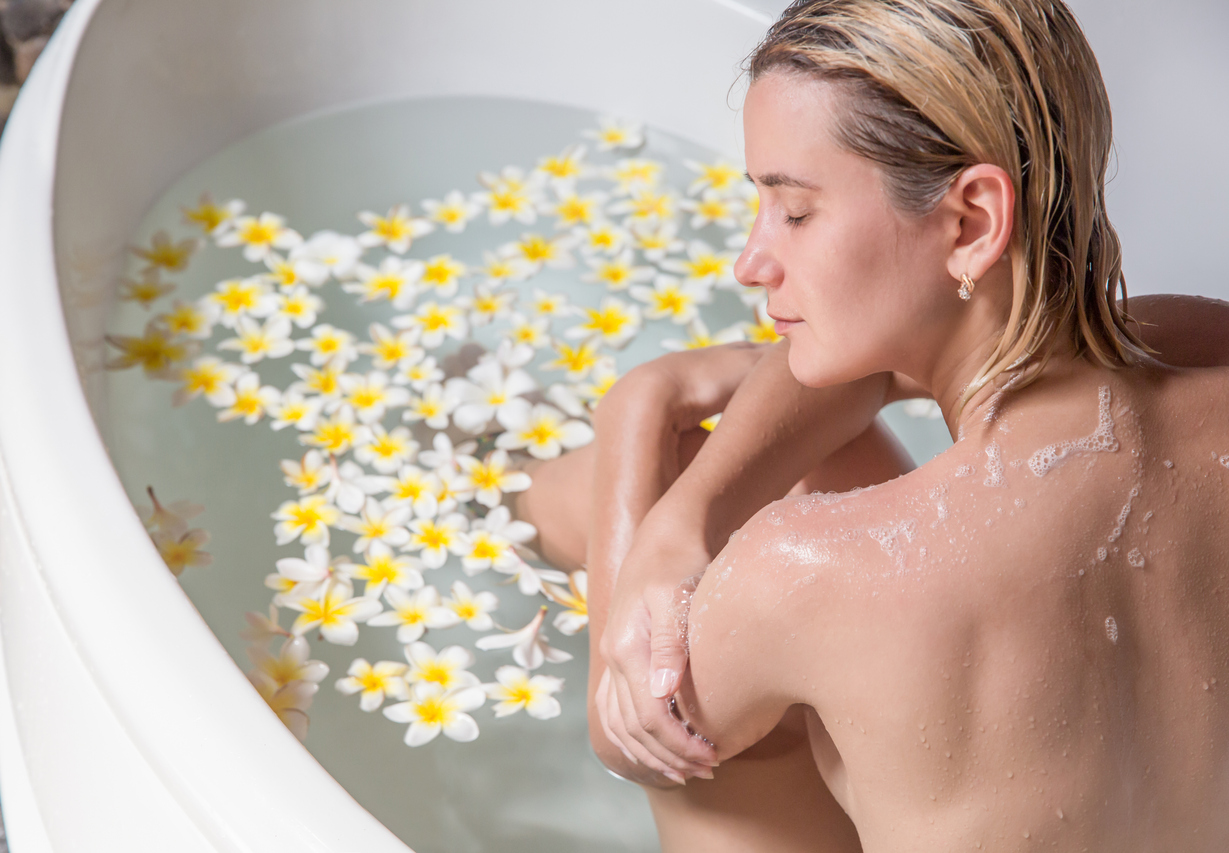Feeling good and keeping a glow on takes self-care and attention—sometimes it feels hard (even impossible!) to make time to take care of ourselves.
As a working mother of two, I have always looked for shortcuts to wellness. Teas, cooking with herbs, and simple oil infusions are easy ways to take care of yourself without breaking the bank, and a natural way to score wellness points since we all have to eat and stay hydrated!
Connecting to the planet—walking barefoot in the grass, stopping to smell the roses, and getting nutrients from natural sources—is an easy way to feel better. Plants offer support for healthy, glowing skin and hair, and can help soothe anxiety, boost mood, and calm your belly.
Look no further than your (sunny!) window garden when prioritizing beauty sleep, glowing skin, mood support, and a little boost of zen. So without further ado, read on to meet a few herbal allies in your quest for well-being:
Get Glowing Skin with Calendula
Calendula is a pretty orange flowering annual that loves the sun and is easy to grow in a pot. Also called Pot Marigold, calendula is known to have anti-inflammatory, antifungal, and antimicrobial properties, and it’s rich in antioxidant components. But calendula’s claim to fame is its support for your skin: it’s used to soothe rashes, eczema, helps heal wounds, and remedy practically any skin complaint. A calendula-infused oil is a soothing moisturizer that’s great for your skin. You can even eat the flowers, sautée the petals in oil to release a saffron flavor in your cooking, or dry them for tea.
Calendula Growing Tips
Find a sunny spot to grow your calendula in a large pot with drainage and water as needed. To encourage flowers, let the plant dry out between waterings for a few weeks. Calendula takes about 55-60 days from sowing to harvest.
How to Make Calendula-Infused Oil
To make calendula-infused oil fill a jar with dried calendula flowers. Pour the oil of your choice–like grapeseed or olive oil—over them. Let the jar sit for a few weeks, shaking it now and again. Strain out the flowers and you have a beautiful, healing oil for your skin.
Rest and Rejuvenate with Chamomile
To get your beauty sleep, drink chamomile tea. The use of chamomile tea dates back to ancient Greece, where it was used as a cold remedy. Nowadays though, chamomile is famous for calming frazzled nerves and promoting rest.
Ever wondered why they call it “beauty sleep”? Sleep has surprising beauty benefits.
Studies have shown that drinking chamomile tea improves sleep quality and reduces insomnia. This may be because chamomile contains antioxidants that bind to receptors in your brain which are thought to promote sleepiness. Along with helping you relax and get a good night’s sleep, chamomile’s benefits include having anti-inflammatory properties thought to support digestive health and benefit blood sugar control, and antioxidants. Chamomile tea has also been used to reduce menstrual pain.
Chamomile Growing Tips
There are two kinds of chamomile – roman and german. For the most abundant flower (and tea!) harvest, choose german chamomile. To grow chamomile, choose a pot that is 12-18 inches wide and has a hole at the bottom to drain since chamomile doesn’t like to be kept too wet. Place your chamomile in a sunny window with at least 6 hours of light. Water when the top ½ inch of soil feels dry and fertilize once a month after your plants have reached a mature height. No need for fertilizer if you plant your chamomile in the ground!
How to Make Chamomile Tea
To make tea, pick the flowers when they bloom and set them on a baking sheet to dry. When they’ve dried, pop a few in a teacup and infuse with hot water.
Calm a Bloated Belly with Mint
Mint tea is a delicious way to calm your stomach and improve your digestive function. Studies have shown that mint tea relaxes the gastrointestinal system, helps soothe an upset stomach, and fights off nausea, gas, and bloating. Studies have found that peppermint even helps improve symptoms of irritable bowel syndrome. Along with promoting a happy gut, mint is a good source of potassium, calcium, vitamins A and C, and folate, as well as antioxidants that protect against aging and chronic illness. It’s also antiviral and antimicrobial, so it supports your immune system.
Mint Growing Tips
Mint is an easy-to-grow perennial. You can grow it from seed or you can find little mint herb plants at garden shops. Give it a sunny window and consistent water and it will be happy.
Discover the joys of growing mint and two mint recipes here.
How to Make Mint Tea
To make tea, just snip some of the plant and steep in water. You can enjoy mint tea from fresh leaves or dried leaves or even pop a few leaves in your bath for a refreshing soak.
Boost Your Mood with Rosemary
Boost your mood and treat dandruff with rosemary. I have grown rosemary for years. My love affair started with a recipe I found in an Andrew Weil article, and it’s been an occupant of my kitchen garden ever since. I just learned this year, though, that there’s more to rosemary than good taste! The aroma of rosemary has been linked to improving the mood, clearing the mind, and relieving stress. Considered a cognitive stimulant, it is known to boost alertness and focus. A source of iron, calcium, vitamins A, C, and B-6, rosemary is rich in antioxidants and anti-inflammatory compounds which support the immune system and help improve blood circulation. And it’s effective against candida albicans – the yeast that causes dandruff!
Rosemary Growing Tips
Grow your rosemary in a pot with drainage, and make sure it has a nice sunny window – it loves the sun! Rosemary prefers dry roots and moist foliage; you can sit your rosemary in a pot that has rocks and water in the bottom – it will enjoy the evaporation–or spritz with a spray bottle.
How to Make Rosemary Water
To boost your mood, memory, and focus, infuse your drinking water with rosemary, make a tea from it, keep a plant or dried rosemary nearby, or use a diffuser with rosemary essential oil.
How to Make a Rosemary Hair Tonic
To add shine to your hair and protect against dandruff, make a rosemary rinse. Boil a couple of tablespoons of fresh rosemary leaves (or a tablespoon of dry leaves) in 2 cups of water for a few minutes in a covered pot. Strain out the rosemary oil, let cool, and use as a final rinse in your hair. You can add some lavender essential oil if you’d like.
Stay Calm, Lemon Balm
Treat anxiety with Lemon Balm. Lemon balm is perennial, is in the mint family, and is named for its lemony scent. Studies have shown that the rosmarinic acid contained in lemon balm helps with stress and anxiety by increasing the availability of some neurotransmitters that are associated with anxiety.
Lemon balm claims other potential benefits related to rosmarinic acid, which has potent antioxidant and antimicrobial properties. Herbs often have a range of benefits related to antioxidants and antimicrobials.
Lemon Balm Growing Tips
To grow lemon balm inside keep it in a sunny spot and don’t overwater. It doesn’t need a big pot since it will grow right up to the edges. You can propagate lemon balm in water. It has a lovely citrusy smell, running your hand over its leaves will release the aroma into the room.
Once it blooms, lemon balm becomes bitter, so keep it cut back to always have sweet-tasting leaves.
How to Make Lemon Balm Tea
To make lemon balm tea snip some leaves and then muddle, cut, or tear them into small pieces, and place them into a tea infuser. Pour hot water over them and let them steep. I also infuse iced drinking water with fresh lemon balm leaves for a refreshing summer cooler.
Start Your Herb Garden for Natural Beauty Remedies
You might be surprised at the potency of these herbs—they are mighty! Simply brushing your hand over their leaves releases oils and scent into the air and onto your skin, and can have an immediate effect. Herbs are also surprisingly beautiful and add charm and life to living spaces.
I keep peppermint and rosemary in my office year-round in a sunny window because they are beautiful, give the room a wonderful fragrance, and have a lively energy that grounds me. It is fun and rewarding to experiment with herbs to find which ones speak to you – which aromas you find the most pleasing, which of them you find the most beautiful, which ones thrive with you, and of course, which ones contribute most to your well-being.
One last note: It’s a good idea to check with your doctor before adding new herbs or supplements to your diet since some herbs can interact with medications or prolonged use can have side effects.
Kirsti Frazier, M.A. Religion, is a writer, blogger, gardener, working mother of two, student of world religions, and producer of botanicals. The owner and gardener at Miller Hill Farm, a revolutionary-era farm near Boston, Kirsti cultivate herbs for botanical tinctures, infusions, teas, and fragrance.











Join the GloWell Community on Social!
Don't risk missing a single thing. Follow us on social and become part of the GloWell community.